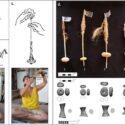Ancient grape seeds show gradual domestication from Bronze Age to Medieval Period.
Stones were likely used by early human cultures as spindle whorls to turn fibers into yarn.
Ancient town of al-Natah, occupied 2400-1500BCE, was an early transitional stage between pastoralism and complex urban settlements.
Study finds discrepancies between intended and actual use of certain areas aboard the space station.
Tool marks could be among oldest known evidence for human occupation in southern South America.
Tools, ceramics, and snail shells provide details of Mycenaean dye production in 16th century BC.
Canoes from Italy reveal early development of advanced nautical technology.
Skeletal pathologies in baboons from near Thebes indicate likely poor diet and limited sunlight.
New dates allow testing of proposed correlations between texts and archaeological remains.
Families moved residence across Mesoamerica and integrated into new societies.
15,000-21,000 years ago, inland Iberia may have been more populated than traditionally thought.
10,000 years of violent conflict revealed by skeletons, weaponry, and rock art.
Indigenous trackers could identify the prints’ species, sex and age for 90% of analyzed engravings.
Analysis of the body ornament from Jordan identifies complex interplay of art, trade, status, and funerary practice.
Stone tools bear tell-tale markings of fiber technology going back 39,000 years.
Finger-marks on a cave wall in France were made before Homo sapiens entered the region.
























